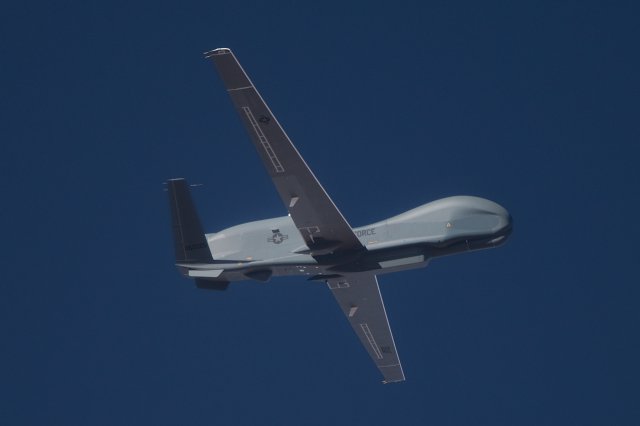 Northrop Grumman Corporation successfully flew a RQ-4 Global Hawk unmanned aircraft for the first time using open architecture-based command and control software and hardware developed by the company, moving the company one step closer to offering its common Mission Management Control System (MMCS) product, which can be implemented across various unmanned aircraft systems (UAS) to improve mission effectiveness and reduce training requirements.
Northrop Grumman Corporation successfully flew a RQ-4 Global Hawk unmanned aircraft for the first time using open architecture-based command and control software and hardware developed by the company, moving the company one step closer to offering its common Mission Management Control System (MMCS) product, which can be implemented across various unmanned aircraft systems (UAS) to improve mission effectiveness and reduce training requirements.
The flight demonstration was conducted last December, and was sponsored by the U.S. Air Force’s Global Hawk Program Office as part of the Ground Station Technical Refresh contract.
The MMCS used for the demonstration was comprised of hardware and software developed by the company’s Common Mission Management System (CMMS) product center. The MMCS is based upon an open, nonproprietary, standards-based, scalable, common architecture and service descriptions.
“The CMMS product center is a game changer. It is a new way of thinking about unmanned aircraft systems and their mission management and control architectures,” said Mike Leahy, director of CMMS for Northrop Grumman Aerospace Systems. “The CMMS approach offers multiple benefits, including savings in both acquisition, and operational and maintenance costs. This approach eliminates stove-piped systems and simplifies training requirements.”
During the flight demonstration, a Global Hawk took off under operator control through the U.S. Air Force Launch and Recovery Element (LRE) at Edwards Air Force Base, Calif. Once airborne, aircraft control was successfully transferred to the MMCS located at the Global Hawk Systems Integration Laboratory in San Diego. The aircraft was then flown through a series of maneuvers until control was transferred back to the LRE for landing.
The Ground Station Technical Refresh contract is a stepping stone for continued development of common UAS control systems that can be used by a variety of unmanned platforms. Currently, each UAS requires a costly dedicated, custom-built command and control system. By developing a common foundation for command and control with sufficient flexibility to meet a range of standards, CMMS will ultimately be able to support a variety of UAS platforms.
The CMMS product line is built upon standard off-the-shelf commercial hardware and core software infrastructure that decreases the time required to develop new unmanned control systems and enhances future technical upgrades because the system architecture is based upon well defined industry standards. Additionally, with the CMMS product line, pilots will be able to operate a variety of dissimilar unmanned platforms using the same informational displays and control features, thereby improving mission effectiveness while reducing training requirements.
“This demonstration validates our approach to common, modular, multiplatform mission control systems,” said Doug Valenzuela, Northrop Grumman’s Programme Manager for the Ground Station Technical Refresh programme. “We were able to reuse components from proven programs and integrate them into a common standards-based infrastructure to establish a baseline that will meet the requirements of multiple programs. This is truly a huge step toward meeting the objective of a common UAS mission control solution.”
Photo: RQ-4 Global Hawk Block 40 / Northrop Grumman
Source: Press Release
